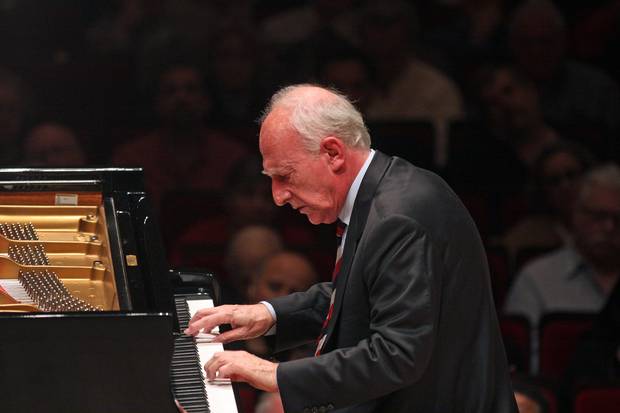Pollini’s magisterial art remains at its finest in Chopin

Many of the audience members for Maurizio Pollini’s solo recital of Schumann and Chopin at Symphony Center on Sunday afternoon surely came armed with expectations. Their chatter was audible as they milled into the hall and whispered between numbers, and exited at the concert’s conclusion. Pollini has been a known quantity in this repertoire for decades. Many have heard him play these pieces before, or owned his celebrated recordings, and their talk centered around whether he is still as marvelous as he was in his fiery youth.
Pollini opened the concert with a performance of Schumann’s Arabeske that offered a master class in pacing. The constant repetitions of thematic ideas in this piece can seem tedious in lesser hands, but Pollini shaped each phrase carefully, pushing forward here, holding back there. His subtle manipulations felt natural and unfussy, and they gave the piece life.
Pollini’s ensuing interpretation of Schumann’s Kreisleriana gave voice to the darker and weightier elements of the piece, sometimes at the cost of its more tender moments. Rather than clarifying the first movement’s knotty opening figures, Pollini blurred them with heavily pedaling, tangling the listener in the notes. The opening of the second and fourth movements were played with a full-bodied tone, rather than with gentleness.
Only in the sixth movement did he reach a true expressive hush. Likewise, he eschewed the characteristic lightness one expects in the fifth movement. The scherzando qualities of the set waited to emerge at last in the final movement. But whenever the music called for a dark, rich sonority, he supplied it majestically. And the wild abandon with which he tackled the seventh movement made it a highlight. It was a surprisingly sober account of a piece that is often treated with a greater sense of fantasy.
The second half of the concert was entirely devoted to Chopin. Though Pollini suffered numerous finger slips throughout these works, none of them could obscure the fact that he remains one of the best living interpreters of Chopin.
From the opening bars of Pollini’s rendition of the Prelude in C-sharp minor, Opus 45, it was apparent that he was going to draw from a broader palette of sound than that employed in the Schumann. Pianissimos were more delicate; dynamic shadings more frequent and colorful.
Pollini’s interpretation of the Piano Sonata No. 2 in B-flat minor retained all of the virtues of his celebrated 1986 recording. He captured the turbulent bustle of the first theme of the opening movement, and slowed down for the second subject just enough to let it breathe, without draining energy. The trio of the scherzo was a marvel of lyrical beauty, and the finale was suitably spooky. Best of all was a gripping, dramatic reading of the famed Funeral March, with well-judged buildups to the climaxes, and an exquisitely sustained central section.
Pollini concluded his program with a diaphanously spun Berceuse and a rousing rendition of the Polonaise in A-flat, filled with all the nobility and vigor one could ask for.
The enthusiastic applause from the audience elicited two further Chopin encores, as strong or stronger than those in his scheduled program. In the passagework of his mellifluous Nocturne in D-flat, Pollini’s fingers were at their most supple. His Scherzo No. 3 in C-sharp minor was imbued with such relentless drive that it belied the fact that it came at the end of such a taxing program.
Posted in Performances




